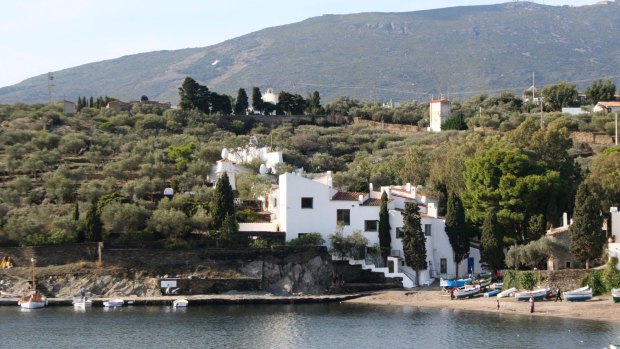
The House-Museum of Salvador Dali, Port Lligat.Credit: Jean-Pierre Chabrol
To say Salvador Dali was a genius is plain understatement. Apart from creating 1500 paintings and thousands of art works, he directed films, wrote a book or two, made a fortune from commercial posters and collected everything you could imagine from Pirelli tyres and eggs to pets that had shuffled off their mortal coil.
As I wander around his former home in Port Lligat on the Costa Brava, I suspect he may have been a pretty decent taxidermist or at least on good terms with one and able to get mates' rates.
There are countless stuffed animals and birds on shelves and in nooks and crannies, even what looks like a miniature donkey in his boudoir, while a polar bear bedecked with rows of gaudy necklaces greets me as I enter the house that Dali and wife Gala shared for more than 30 years from 1949.
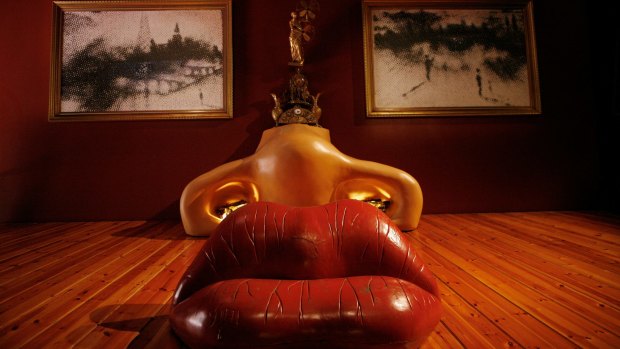
The Mae West room, Dali Museum, Figueres.
I've always thought the Spanish were the most creative people on earth and when you add Dali's special blend of eccentricity and flamboyance, well, this place is a sensory overload on steroids. A trip to see his prodigious collection is no staid visit to an art gallery. Gobsmacking and amazing, you need a week to take it in.
I'm visiting two points of the Dali Triangle – an area in Catalonia, Spain, where Dali was born, lived and created museums and castle-like homes.
As I'm travelling from Barcelona by public transport, it's not possible to hit all three points of the triangle in the four days I've allotted myself. I decide to visit Figueres and Cadaques (from the latter I walk to nearby Port Lligat) and drop Pubol from the list. Later I'm told I "should" have included Pubol, where Dali built a home for Gala, but time is my enemy and I'm pretty sure Dali would understand as he was fascinated by time and (melting) watches.
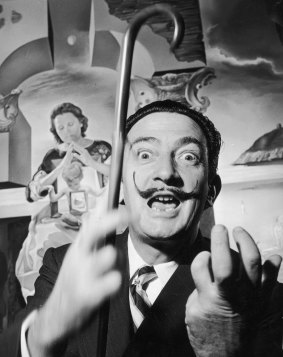
Salvador Dali in London with one of his paintings entitled The Madonna of Port Lligat.Credit: Getty Images
From Barcelona, one of the artiest cities on the planet, it's a two-hour train ride to Figueres where Dali was born in 1904.
From the station, I drag my bags past the market to the Rambla (like Barcelona, Figueres also has one of these pedestrian streets) to my hotel.
I'm spending two nights at the Hotel Duran, and I can't help making lame comments on Facebook as to whether Simon Le Bon ever stayed there. He didn't – but Dali dined there. I follow suit and eat alone, in the ornate restaurant under glass blown chandeliers, on delicious tapas as red-jacketed waiters fill my glass with excellent quaffing wine – Spanish wine is so cheap it gives Dan Murphy's a serious run for its money.
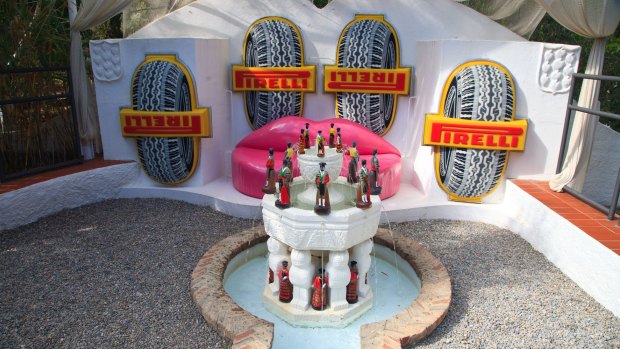
At Salvador Dali's house in Port Lligat near Cadaques, the seating area beside his swimming pool.Credit: Tim Wright / Alamy
The Dali Theatre-Museum is a stroll from the hotel and my booked entry time is 9am. His museums are so popular that visitors must book specific entry times. However, once you've entered you can stay as long as you like.
Rebuilt on the site of a former theatre destroyed during the Spanish Civil War, the museum was a collaboration between Dali and the local mayor. It houses the largest and most diverse collection of his works from paintings, 3D collages, jewels, sculptures and a quirky installation, the Mae West apartment, where I swear that the weird synthetic substance that is supposed to adorn her head looks like Donald Trump's unruly barnet.
There are so many art works, it's hard to know where to start once you get past the jaw-dropping courtyard where a Cadillac, on which stands a voluptuous statue of the goddess Esther, takes pride of place. It's best to step straight into the cavernous main gallery topped by a glorious glass dome, called a geodesic cupola, which looks even better when viewed from outside.
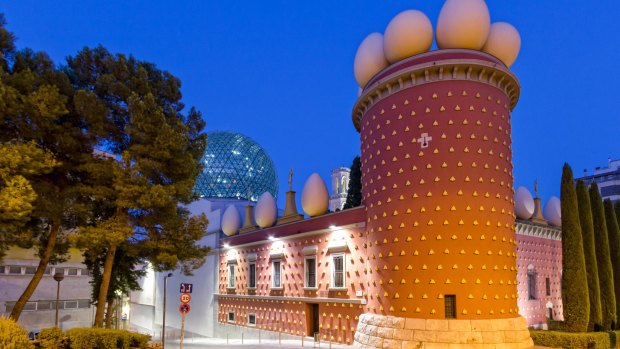
The Dali Theatre and Museum.Credit: Alamy
My advice is grab a guide, walk hither and thither and be bedazzled. The melting watches painting, The Persistence of Memory, is upstairs in a roped-off corner of another huge gallery above a crazy golden bed whose four "legs" are fashioned as misshapen sea serpents. And don't forget the Dali Jools, a collection of jewellery in a separate building where the key piece, a ruby-encrusted heart, actually "throbs" behind its glass case.
Three hours of wandering and it is time to hit the streets to find a cafe con leche and a toasted sandwich. I wander into St Peter's church where Dali was baptised, walk past the rather unassuming house where he was born and end up at the Museu del Joguet (toy museum) where old-fashioned teddy bears and Scalextric cars are packed into display cases, together with photos of local children of years gone by, with just the odd photo or two of Dali as a boy.
By night fall on this June day, Figueres is deserted – the day-trippers have returned to Barcelona – and I dine in a small restaurant just off the Rambla, the only customer at 9.15pm.
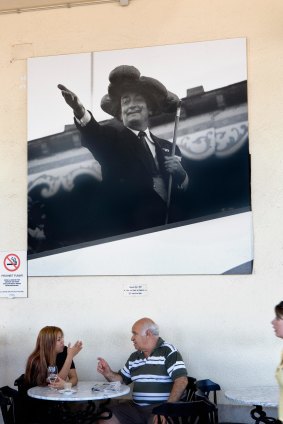
The Casino bar in Cadaques.Credit: Alamy
From Figueres it's just over an hour by bus to Cadaques via seaside towns with sparkling new apartments and boat-filled marinas and winding mountain roads. This is where Dali spent his childhood holidays. Today, still gorgeous, it is favoured by the Brits and I meet an English couple who holiday here every year and happily give me the lowdown on the place.
Not wanting to lose the Dali buzz, I trudge over the well-trodden path to Port Lligat and await my scheduled turn to enter his bizarre abode. Two silver heads sit atop the terracotta roof and big eggs (another Dali theme) rest on turrets and terraces, some whole and one artistically cracked. Outside those Pirelli tyres border a fun T-shaped swimming pool and a well-placed mirror projects an image of me standing upside down.
The place is a hoot, a wacky blend of the ornate and ordinary (like the items you'd find in any Vinnies op shop) but thrown together in brilliant bravura.
Dali chose well; Port Lligat is charming – little development save one hotel, a pop-up beach cafe – and views of headlands and olive trees.
Cadaques is a whitewashed town, reminiscent of those you see on Greek islands with seaside cafes by the dozen and day-tripper boats heading off sightseeing.
Discovering Dali is tiring work but, thankfully, the towns with his museums make excellent places to linger and lounge about.
I'm kind of glad I didn't have time to visit Gala's castle in Pubol. I'm determined to come back and complete the triangle.
TRIP NOTES
MORE
FLY
Emirates flies to Barcelona (via Dubai) daily. Return fares between Sydney/Melbourne and Barcelona are from $1550 a person; see emirates.com/au
TRAIN
Getting to Figures from Barcelona is a little confusing as there are two stations in Figueres. Almost in the centre of town (and closest to the Dali Theatre-Museum) is Figueres, just under two hours from Barcelona. Figueres Vilafant is 2.5 kilometres away but has a 55-minute fast train service. Both can be booked through the train network Renfe with fares starting at $14.15 one-way; see renfe.com
BUS
To get to Cadaques, bus is the only way (unless you drive). The bus station is next door to the Figures main town railway station with the trip taking an hour. The schedule varies according to the season and fares start at $7.80. See compras.moventis.es/en-GB
TOUR
All three Salvador Dali museums and houses (including the Gali Dali house-museum in Pubol) need to be booked in advance online with entry times allotted. Museums open from 9am to 10.30am and close from 5pm to 8pm depending on the season. See salvador-dali.org/en
STAY
Hotel Duran is pleasant old-style accommodation and has renovated comfortable rooms overlooking the Rambla. The bar features quite a lot of Dali memorabilia such as photos of the artist and a few sketches. It's a short walk from the Dali Theatre Museum. From $89 a night (see hotelduran.com). Hotel Nou Estrelles in Cadaques is a friendly, family-run hotel close to the bus terminus and harbour. Rooms are minimalist and modern, from $85 a night, low season; $11 buffet breakfast (see hotelnouestrelles.com).
Caroline Gladstone was assisted by Royal Caribbean Cruises and Spain's Tourism Board.
Sign up for the Traveller Deals newsletter
Get exclusive travel deals delivered straight to your inbox. Sign up now.